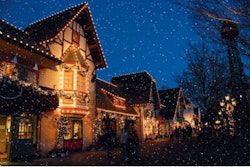Tough plants that survive winter’s wrath with style
Winter landscapes don’t have to be lackluster. A planting plan that includes specimens such as Yellow Ribbon Arborvitae with its lemon-colored edges, the waving plumes of Feather Reed Grass, and the striking orange-red twigs of Winter Flame Dogwood is as attractive as it is hardy. “Plants with color, texture and form keep the landscape vibrant year-round,” says landscape architect Jim Hanson, of Hanson Design Associates in Fargo, North Dakota.
“By selecting plants that offer both cold tolerance and wintertime good looks, your work, as well as your client’s property, will stand out.”
To choose the best plants for your project, consider these points:
Get the best local knowledge.
“Talk to local nursery experts and ask them what selections work in your area,” says J’Nell Bryson, a landscape architect in Charlotte, North Carolina. “They know their plant materials and can keep you updated on general care, companion plantings and plant introductions.”
Think about placement.
“If you have zone 7 hardiness, for example, but you plant where you’ll get hot afternoon sun, you should consider the potential for sun scald and the effect on the plant,” says Bryson “It’s not always cut-and-dried as to what works where.” For example, a camellia may be suited to your climate, but in eastern or southern exposures, it may experience temperature extremes (warm during the day and freezing at night) that could affect bloom.
Try something new.
Sure, you want to stick with plants that have performed consistently for you in the past, but new varieties, which are often more cold or disease hardy or just plain prettier, are being released constantly. “I try a few plants that are new to me every year because that’s the only way you’re going to expand your plant palate,” says Hanson. A few of his recent favorites: Tiger Eyes Cutleaf Staghorn Sumac, Diabolo Ninebark, Prairie Petite Lilac, and Morden Ruby Rose. See the next page for more examples of plants that offer color and texture in winter.
Tough Plants that Winter Well
Trees and shrubs Tip: These trees and shrubs offer year-round color, texture and architectural interest.
Autumn Magic Black Chokeberry (zones 3-7, full sun) has fragrant flowers in spring, followed by clusters of purple-black berries. Great red and purple fall color.
The Blues Blue Spruce (zones 2-8, full sun) is a striking, new evergreen by Monrovia. It’s silvery-blue with dramatic weeping branches. Unusual shape so it’s a great focal point.
Dwarf Blue Leaf Arctic Willow (zones 4-6, full sun) has a nice blue-green color with purple twigs in winter. Good for hedges.
Yuletide Camellia (zones 7-10, partial sun) boasts striking blooms in November and December in vibrant pink or red with a yellow center. It works well as a shrub or espalier.
Grasses Tip: To provide winter interest and shape to the landscape, cut back grasses in the spring.
Sedge (zones 4-9, partial shade) has numerous varieties in shades varying from chartreuse to bronze. Adds color and texture to edge a walk or as an accent.
Hameln Dwarf Fountain Grass (zones 4-9, full sun) only gets about two feet tall. Soft plumes look great in mass plantings.
Northwind Switch Grass (zones 4-9, full sun) has upright, steel blue stems. Nice as a specimen or in mass plantings.
Prairie dropseed (zones 3-9, full sun) has an upright, arching clump texture. It’s a slow-grower and looks good even when the seed clumps droop over at season’s end.
Perennials Tip: New perennial varieties dress up projects and yield more bang for your buck.
Beesia (zones 6-8, partial to full shade), introduced by Monrovia, has a shiny green, bluish tint with heart-shaped leaves and star-shaped flowers in mid to late spring. Less invasive than Pachysandra.
Coral Bells (zones 4-9, partial shade to full sun) has dramatic, glossy foliage in colors ranging from amethyst to peach to burgundy-black. Evergreen in warmer climates.
Starburst Daylily (zones 7-11, full sun) are repeat bloomers with more disease-resistance than some other varieties. Evergreen in temperate climates.
Violas and Pansies (zones 5-9, partial to full sun) offer color in early spring, spring, and fall, and they overwinter well. Sorbet viola and the new Plentifall spreading pansy by Ball Horticultural boast outstanding cold weather hardiness, reblooming in spring. In warm climates, they provide winter-long color in a rainbow of shades.
To determine your area’s hardiness zone go to http://www.usna.usda.gov/Hardzone/ushzmap.html.
To learn more about the flowers mentioned in this article, visit ballhort.com or monrovia.com.










